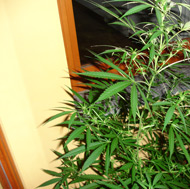Hobby Seed breeding
Many people ask many questions about making their own seeds from the plants they have been growing for sometime, so in this issue I shall deal with some factors to consider while making seed. We will cover some of the facets to look for in males of the species plus try to identify all the possible areas involved in the process of seed production so you the grower can feel confident enough to attempt this type of work. Making a product by using nature's ways is a most satisfying accomplishment to any gardener of any plant.
Most home growers have experience selecting a female plant, as this sex of the plant contains the flower clusters and makes more quantities of cannabinoids; the active ingredients unique to cannabis , than the male plant. So as a general rule if you want your female plant to reach its potential as a maker of substantial quantities of Cannabinoids you must kill any of the male flowers since their union will cause the female plant to become impregnated with male pollen and as a result seed will begin to form in the female flowers. Since a lot of energy of the plant is taken up making seeds, at this stage, there will be a reduction of cannabinoids as a consequence. That is the reason most growers prefer to grow a female plant without the presence of a male plant: to produce sinsemilla (without seeds) flowers.
Therefore it is important to note that to produce your own seed you will need to have both a female and male plant present at the correct moment. Considering male plants tend to flower, like the female plants, when they are exposed to 12 hours dark a day a little quicker than the female plant, you will need to time your plants life well to maximize the viable seed produced.
Cannabis is a heterozygotic plant; taking its genetic make-up from both parents .So selectively breeding cannabis for the particular traits that you want can be done by choosing particular phenotypes and genotypes from each new seed generation.

An example of this is best illustrated by beginning with two pure species such as Indica and Sativa. Let us say the male plant is a pure indica from Afghanistan. Its traits are broad leaf, dark green coloration, strong fruit scent, short dense flower clusters, and a tendency to flower quickly finishing in 7 weeks. If we then combine the male to a pure sativa female originating from Thailand with traits; long slender leaf shape, lime green to olive green shades, piney/spice scent, long airy flowers, and a tendency to have a long flowering time of over 10 weeks - we will get a lot of different combinations to select from. Testing a lot of the resulting generation seed (F1) will be necessary to see which combination is in line with the genetic area of interest you wish to follow.
F1 seed will express itself from this hybridization of sativa and indica by showing its phenotypes to express predominantly sativa traits as well as predominantly indica traits as well as a large proportion of the F1 seeds expressing a combination of both parents in different amounts. Considering phenotype will express certain traits the biggest or hardest job is to identify the particular F1 plant that carries the genotype that combines those characteristics in DNA coding. This is really done through trial and error and consecutive generations and a lot of testing - this is what we term SELECTIVE BREEDING.
In practical terms how do we produce that desired F1 seed? If we continue using the sativa : indica example I can guide those who wish to attempt it.
Page 1 | Page 2
|
|||||||||
 |

|

